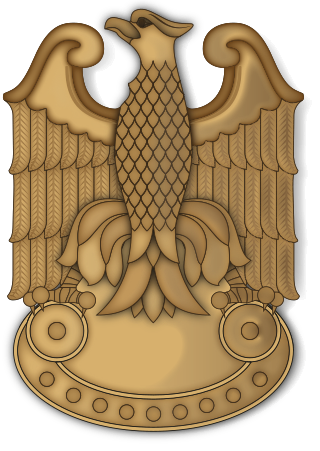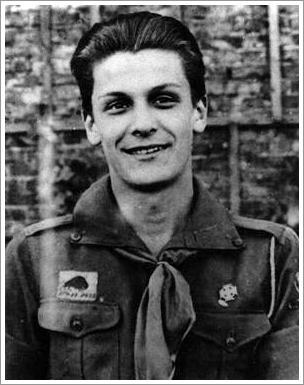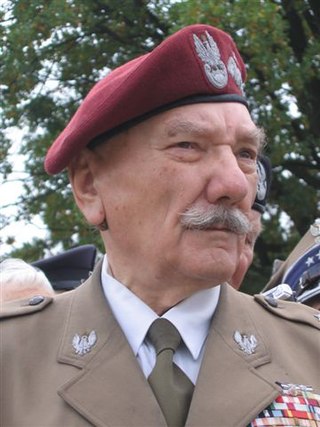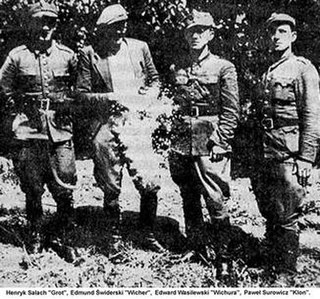
The Heim ins Reich was a foreign policy pursued by Adolf Hitler before and during World War II, beginning in 1936 [see Nazi Four Year Plan; Grams, 2021]. The aim of Hitler's initiative was to convince all Volksdeutsche who were living outside Nazi Germany that they should strive to bring these regions "home" into Greater Germany, but also relocate from territories that were not under German control, following the conquest of Poland, in accordance with the Nazi–Soviet pact. The Heim ins Reich manifesto targeted areas ceded in Versailles to the newly reborn state of Poland, various lands of immigration, as well as other areas that were inhabited by significant ethnic German populations, such as the Sudetenland, Danzig, and the southeastern and northeastern regions of Europe after 6 October 1939.

Krzysztof Kamil Baczyński, was a Polish poet and Home Army soldier, one of the most well known of the Generation of Columbuses, the young generation of Polish poets, of whom several perished in the Warsaw Uprising and during the German occupation of Poland.

Kedyw (Polish pronunciation:[ˈkɛdɨf], partial acronym of Kierownictwo Dywersji was a Polish World War II Home Army unit that conducted active and passive sabotage, propaganda and armed operations against Nazi German forces and collaborators.
Operation Belt was one of the large-scale anti-Nazi Germany operations of the Armia Krajowa Kedyw during World War II.

The kotwica was an emblem of the Polish Underground State and Armia Krajowa used during World War II. It was created in 1942 by members of the Wawer minor sabotage unit within the AK, as an easily usable emblem for the struggle to regain the country's independence. The initial meaning of the initialism PW was pomścimy Wawer, in reference to the 1939 Wawer massacre, which was considered to be one of the first large scale massacres of Polish civilians by German troops in occupied Poland.

The People's Army was a communist partisan force of the Polish Workers' Party (PPR) active in Occupied Poland during World War II from January to July 1944. It was created on the order of the Soviet-backed State National Council to fight against Nazi Germany and support the Red Army against the German forces in Poland.

"Grey Ranks" was a codename for the underground paramilitary Polish Scouting Association during World War II.

Maciej Aleksy Dawidowski codename: Alek, Glizda, Kopernicki, Koziorożec was a Polish scoutmaster (podharcmistrz), Polish Scouting resistance activist and Second Lieutenant of the Armia Krajowa during the Second World War. Dawidowski is a main character in the books Kamienie na Szaniec by Aleksander Kamiński, and Rudy, Alek, Zośka by Barbara Wachowicz.
During World War II, resistance movements operated in German-occupied Europe by a variety of means, ranging from non-cooperation to propaganda, hiding crashed pilots and even to outright warfare and the recapturing of towns. In many countries, resistance movements were sometimes also referred to as The Underground.

Jędrusie was a Polish underground guerrilla group during World War II, created in 1941.

In Poland, the resistance movement during World War II was led by the Home Army. The Polish resistance is notable among others for disrupting German supply lines to the Eastern Front, and providing intelligence reports to the British intelligence agencies. It was a part of the Polish Underground State.

Tadeusz Żenczykowski, pseudonym Kania, Kowalik and Zawadzki was a Polish lawyer, political activist and soldier in the Armia Krajowa during World War II, taking part in the Warsaw Uprising of 1944. Immediately after the war, he was a member of the anti-communist conspiracy in Poland. In 1945, he emigrated and became a journalist and deputy chief of the Polish Section of Radio Free Europe, historian and publicist.

Józef Szczepański was a Polish poet who was a member of the Armia Krajowa Polish resistance. Commander of the Battalion Parasol during the Warsaw Uprising, known under his codename Ziutek, he was also a notable poet of the occupation period. Many of his poems were made into songs; the most notable one was "Pałacyk Michla".[a]

A minor sabotage during World War II in Nazi-occupied Poland (1939–45) was any underground resistance operation that involved a disruptive but relatively minor and non-violent form of defiance, such as the painting of graffiti, the manufacture of fake documents, the disrupting of German propaganda campaigns, and the like. Minor-sabotage operations often involved elements of humor.
Operation Bürkl, or the special combat action Bürkl, was an operation by the Polish resistance conducted on 7 September 1943. It was the second action of Operation Heads, a series of assassinations of notorious SS officers in Warsaw carried out by the Kedyw's special group Agat ("Anti-Gestapo") between 1943 and 1944, and their first success.

Operation Antyk, also known as Department R, was a complex of counter-propaganda activities of Polish resistance movement organisation Home Army, directed against pro-Soviet and pro-communist circles in Polish society, mostly members of the Polish Workers' Party. The operation was initiated by Office Antyk of the Home Army’s Bureau of Information and Propaganda. Begun in November 1943, it was directed by Tadeusz Żenczykowski.

Anna Zakrzewska served with the Polish underground army as a courier and a medical orderly. She was killed in the course of desperate combat during the Warsaw Uprising.

Stanisław Komornicki was a brigadier general in the Polish Army and the chancellor of the Order Virtuti Militari. He was born in Warsaw. He was a Polish underground activist, a member of underground Scouting, a soldier of Armia Krajowa, a participant in the Warsaw Uprising, an officer of the Polish First Army, a participant in the Battle of Kolberg, a writer, and a military historian.

Edward Wasilewski, pseudonym Wichura, was one of the best known anti-communist fighters in the Polish resistance during the Soviet takeover of Poland. Under his command, 44 underground soldiers successfully attacked the NKVD camp in Rembertów on the night of 20–21 May 1945, and liberated 700–1000 NKWD prisoners. Wasilewski was arrested on 26 March 1946 and, after a year spent in prison, was broken by agents of the Ministry of Public Security. He worked as an informant until 1960, denouncing many of his former colleagues. He killed himself by jumping out of a window in 1968, on the day of the Warsaw Pact invasion of Czechoslovakia.

Parole der Woche was a wall newspaper published by the Reichspropagandaleitung der NSDAP from 1937 to 1943. Historian Jeffrey Herf describes Parole der Woche as "the most ubiquitous and intrusive aspect of Nazism's visual offensive ... no form of Nazi visual propaganda made so crucial a contribution to the regime's presentation of ongoing events".




















